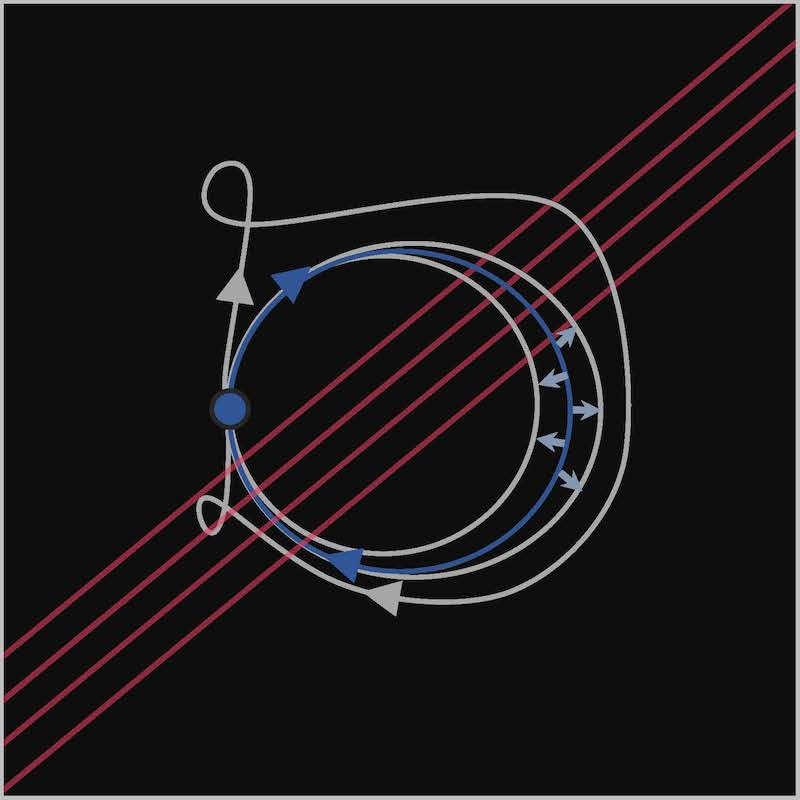Jun 27 2019
Nature can find best solutions to complicated problems. For instance, although there are more ways for a single protein to fold, proteins invariably fold in a manner that lowers potential energy.
 The modes of an optical frequency comb (red lines) are locked together by a variational principle. This principle defines a specific path (blue line) in the vast parameter space of the laser, which is preferred to any other path (grey lines) obtained by small variations of this trajectory. In obeying this variational principle, the laser guarantees to maximize its output power. (Image credit: Image courtesy of the Capasso Lab/Harvard SEAS)
The modes of an optical frequency comb (red lines) are locked together by a variational principle. This principle defines a specific path (blue line) in the vast parameter space of the laser, which is preferred to any other path (grey lines) obtained by small variations of this trajectory. In obeying this variational principle, the laser guarantees to maximize its output power. (Image credit: Image courtesy of the Capasso Lab/Harvard SEAS)
Slime mold is a brainless organism that can always identify the most efficient path to a food source, even when presented with an impediment. When both ends of the jump rope are clutched, it always results in the same shape, a curve called catenary.
This type of optimization is described by a so-called variational principle: any other deformation—or variation—of the shape found by the mold, protein, or jump rope would need further energy.
Currently, scientists at the Harvard John A. Paulson School of Engineering and Applied Sciences (SEAS) have discovered that some lasers apply the same principle. The study has been reported in Physical Review Letters.
Frequency combs are commonly used, high-precision tools that can measure and detect various frequencies—also known as colors—of light. Different from the conventional lasers that can produce a single frequency, these lasers produce multiple frequencies in lockstep and are uniformly spaced just as the teeth of a comb.
When a frequency comb is produced by a laser, periodically repeated waves of light are emitted from the laser. Based on the comb’s parameters, these waves can have steady intensity with variation in color or can appear as short pulses of light that can increase and decrease in intensity.
Despite the fact that scientists know how combs emit pulses, it has remained a long-standing mystery on how the so-called frequency-modulated lasers are able to maintain a constant intensity even with varying frequencies.
Under the guidance of Federico Capasso, the Robert L. Wallace Professor of Applied Physics and Vinton Hayes Senior Research Fellow in Electrical Engineering, the research team managed to reconstruct on a time scale of a trillionth of a second the waveform produced by the light sources called quantum cascade lasers.
The researchers discovered that the lasers prefer to emit light waves in a way that can inhibit the intensity variations—resulting in a constant intensity in time—and increase the power output.
We discovered that a frequency-modulated laser can adjust parameters by itself, similar to a DJ turning knobs on a music synthesizer, to minimize fluctuations of the emitted intensity wave. Turning all these knobs in the right way is not an easy task. In producing a nearly-flat intensity waveform, the frequency-modulated laser has solved a complex optimization problem, performing just like an analog computer.
Marco Piccardo, Study First Author and Postdoctoral Fellow, SEAS
According to Capasso, “This discovery unravels the physics of a promising frequency comb technology. Benefitting by a minimal intensity modulation at the laser output, these devices could rival conventional ultra-short pulse mode-locked lasers in spectroscopy applications.”
The study was co-authored by Paul Chevalier, Benedikt Schwarz, and Dmitry Kazakov of SEAS, and Yongrui Wang and Alexey Belyanin of Texas A&M University. It was financially supported by the National Science Foundation.